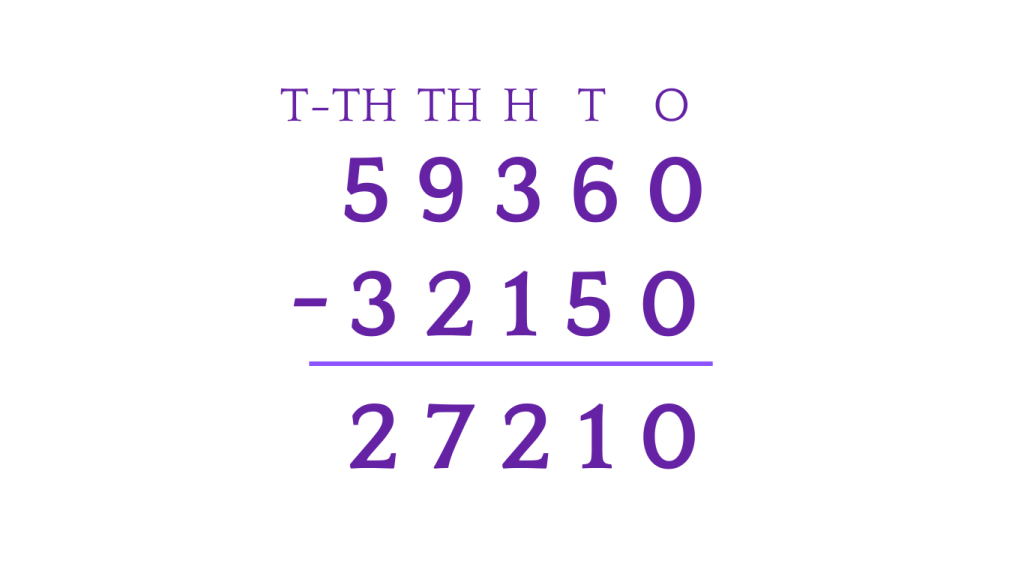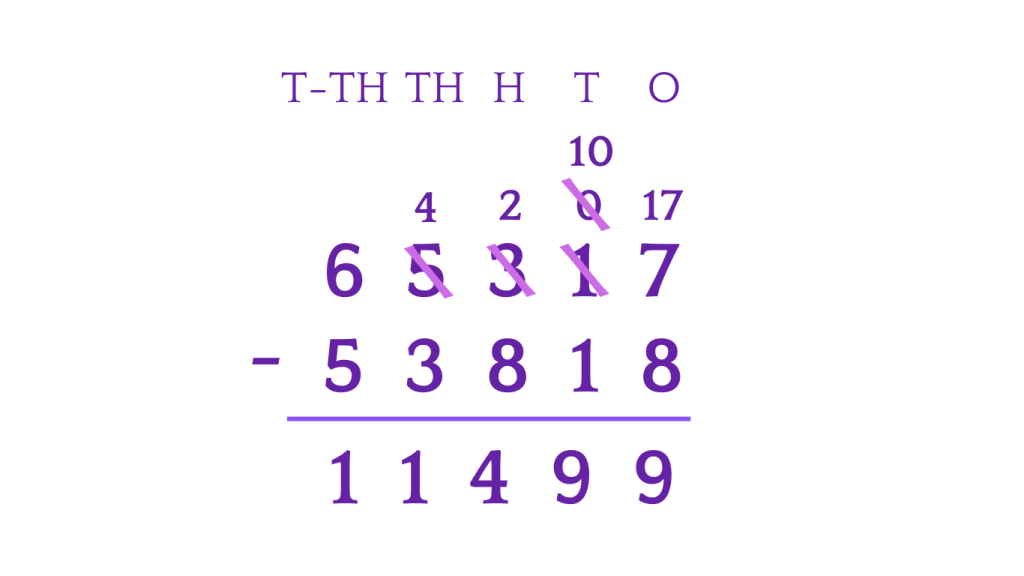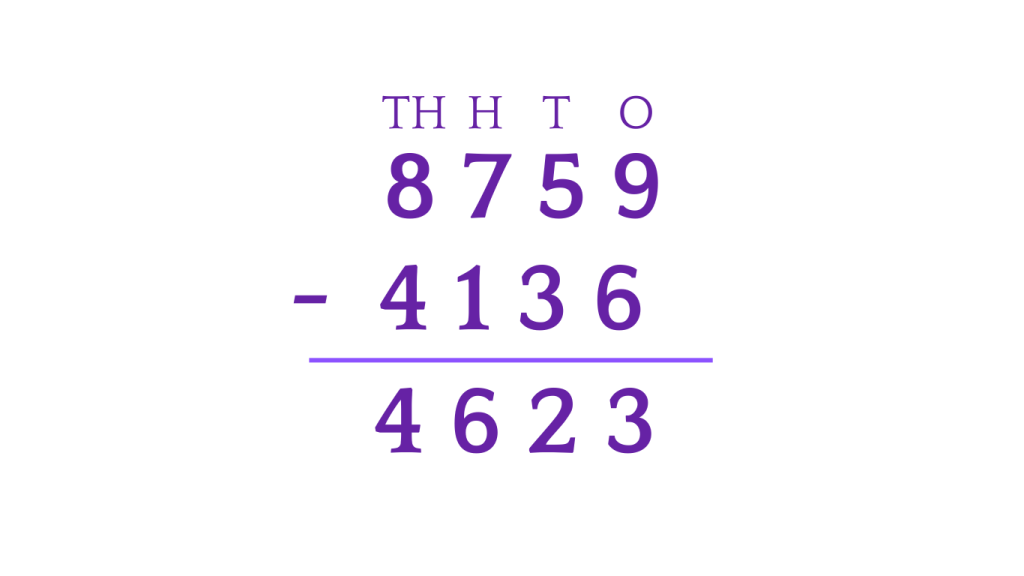Subtraction – Methods and Examples
Table of Contents
Introduction
Subtraction
In the realm of mathematics, subtraction is a fundamental operation that involves finding the difference between two numbers. It is denoted by the minus (-) symbol and plays a crucial role in various mathematical calculations. Let’s explore the concept of subtraction and its applications in solving numerical problems. It is one of the four basic arithmetic operations which are addition, subtraction, multiplication and division.
Analogy of Definition
What is Subtraction?
Subtraction is the process of taking one number away from another. It is represented by the minus (-) symbol, which signifies the operation of finding the difference between two quantities. The result of a subtraction operation is called the “difference.”
Minus Sign in Subtraction
The minus sign (-) is a fundamental symbol used in mathematical operations to denote subtraction. It is employed in various contexts, such as subtracting numbers, finding the negative of a quantity, and indicating a decrease in value. Understanding the role of the minus sign is essential for mastering subtraction in mathematics.

Method
Methods of Subtraction
There are several methods for performing subtraction, each suited to different scenarios. Some common techniques include subtraction on a number line, mathematical operations using the minus sign, subtraction with the column method, and subtraction with regrouping.
Subtraction on a Number Line
Subtraction on a number line is a visual method that helps in understanding the concept of taking away one quantity from another. It involves representing the starting number on the number line and then moving backward to find the difference. This method is particularly useful for teaching subtraction to young learners and visual learners. Let us subtract 4 and 2 by using a number line. We will begin by marking at 4. To subtract using a number line, we will subtract 2 from 4 by moving two units to the left. The number we land of after moving two units to the left is 2, so subtracting 2 from 4 gives us a difference of 4.

Subtraction with Column Method
The column method is a systematic approach to performing subtraction, especially for multi-digit numbers. It involves aligning the numbers vertically and subtracting each place value from right to left, taking into account any necessary borrowing or regrouping. This method provides a structured way to perform complex subtractions with ease.
Example: Subtract 59360 and 32150
To subtract the numbers, we will first begin with subtraction of the digit on the right, i.e, the digits in the ones column, subtracting 0 by 0 gives us 0. Then, we will move to the digit on the tens place which is 6 and 5, subtraction 6 by 5 gives us 1, we will carry out the same process for all columns to get the final result.

Subtraction with Regrouping
Subtraction with regrouping, also known as borrowing, is a technique used when the digit being subtracted is larger than the digit it is being subtracted from. In such cases, regrouping is necessary to perform the subtraction accurately. This method is crucial for handling complex subtractions involving multi-digit numbers.
Example: Subtract 65317 and 53818
Step 1: We will begin at the right with digits at ones place, since 8 is greater than 7 we will borrow one from the tens column which will make it 17. 17 – 8 will be 9.
Step 2: In the tens column, after giving 1 to the ones column, we have 0 left which is less than 1, so we will borrow 1 from hundreds place will make it 10, then 10 – 1 will be 9.
Step 3: In the hundreds place, after giving 1 to tens place, wehave 2 left which is less than 8, so we borrow 1 from thousands place, which makes it 12, then 12 – 8 will be 4
Step 4: Subtracting digits in the thousands place we get 4 – 3 = 1.
Step 5: Subtracting digits in the ten thousands place we get 6 – 5 =2. Thus, the difference will be 11499.

Examples
Example: Subtracting 4163 from 8759
Step 1: Align the numbers vertically
Step 2: Perform subtraction from right to left
So, the difference between 8759 and 4163 is 4623.

Quiz
Tips and Tricks
1.Counting Backwards
Tip: Start with the larger number and count backward the amount you’re subtracting. For example, to subtract 7 from 15, start at 15 and count back 7 steps: 15, 14, 13, 12, 11, 10, 9. The answer is 8.
2.Using Number Lines
Tip: Draw a number line and mark the starting number. Then, move left on the number line to represent subtraction. For instance, if you’re subtracting 3 from 8, start at 8 and move three spaces to the left to land on 5.
3.Break it Down
Tip: Break down larger numbers into smaller, more manageable parts. For example, if you’re subtracting 68 from 100, you can break it down into 60 and 8, then subtract each part separately: 100 – 60 = 40 and 40 – 8 = 32. Add the results together: 40 + 32 = 72.
4.Estimation
Tip: Round the numbers to make the subtraction easier. For instance, if you’re subtracting 47 from 92, you can round 92 to 90 and 47 to 50. Then, subtract 50 from 90 to get 40. Adjust for the rounding: 40 – (50 – 47) = 40 – 3 = 37.
5. Use Mental Math
Tip: For smaller numbers, practice doing the subtraction mentally to improve your speed and accuracy. For example, 18 – 7 can be quickly calculated by knowing that 10 – 7 is 3 and then adding the remaining 8 to get 11.
Real life application
Story: “The Subtraction Adventures of Sam and Maya”
Sam and Maya were two adventurous friends who encountered various real-life situations where the concept of subtraction played a crucial role in solving everyday challenges.
Challenge 1: The Shopping Spree
Sam and Maya went on a shopping spree and bought a total of 785 items. After returning home, they realized that they needed to return 456 items. Using their knowledge of subtraction, they quickly calculated the difference and determined that they had 329 items left.
Challenge 2: The Library Quest
During a visit to the library, Sam and Maya borrowed a total of 987 books. After reading, they returned 512 books to the library. By performing subtraction, they found that they still had 475 books in their possession.
Challenge 3: The Fruit Stand Adventure
At a local fruit stand, Sam and Maya purchased 654 fruits. After sharing some with friends, they were left with 289 fruits. Subtraction helped them determine that they had 365 fruits remaining.
Challenge 4: The Toy Store Expedition
While exploring a toy store, Sam and Maya found 876 toys that caught their eye. After purchasing some, they realized that they had 398 toys left. Subtraction revealed that they had 478 toys in their collection.
Challenge 5: The Puzzle Box Mystery
In a puzzling adventure, Sam and Maya discovered a box containing 789 pieces. After using some pieces, they counted 256 remaining. Subtraction helped them determine that they had 533 pieces left to solve the puzzle.
FAQ's
Like? Share it with your friends






